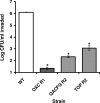Phenotypic and proteomic characterization of multiply antibiotic-resistant variants of Salmonella enterica serovar Typhimurium selected following exposure to disinfectants
- PMID: 18083849
- PMCID: PMC2258635
- DOI: 10.1128/AEM.01931-07
Phenotypic and proteomic characterization of multiply antibiotic-resistant variants of Salmonella enterica serovar Typhimurium selected following exposure to disinfectants
Abstract
In previous work, Salmonella enterica serovar Typhimurium strain SL1344 was exposed to sublethal concentrations of three widely used farm disinfectants in daily serial passages for 7 days in an attempt to investigate possible links between the use of disinfectants and antimicrobial resistance. Stable variants OXCR1, QACFGR2, and TOPR2 were obtained following treatment with an oxidizing compound blend, a quaternary ammonium disinfectant containing formaldehyde and glutaraldehyde, and a tar acid-based disinfectant, respectively. All variants exhibited ca. fourfold-reduced susceptibility to ciprofloxacin, chloramphenicol, tetracycline, and ampicillin. This coincided with reduced levels of outer membrane proteins for all strains and high levels of AcrAB-TolC for OXCR1 and QACFGR2, as demonstrated by two-dimensional high-performance liquid chromatography-mass spectrometry. The protein profiles of OXCR1 and QACFGR2 were similar, but they were different from that of TOPR2. An array of different proteins protecting against oxidants, nitroaromatics, disulfides, and peroxides were overexpressed in all strains. The growth and motility of variants were reduced compared to the growth and motility of the parent strain, the expression of several virulence proteins was altered, and the invasiveness in an enteric epithelial cell line was reduced. The colony morphology of OXCR1 and QACFGR2 was smooth, and both variants exhibited a loss of modal distribution of the lipopolysaccharide O-antigen chain length, favoring the production of short O-antigen chain molecules. Metabolic changes were also detected, suggesting that there was increased protein synthesis and a shift from oxidative phosphorylation to substrate level phosphorylation. In this study, we obtained evidence that farm disinfectants can select for strains with reduced susceptibility to antibiotics, and here we describe changes in protein expression in such strains.
Figures





Similar articles
-
Commonly used farm disinfectants can select for mutant Salmonella enterica serovar Typhimurium with decreased susceptibility to biocides and antibiotics without compromising virulence.J Antimicrob Chemother. 2007 Dec;60(6):1273-80. doi: 10.1093/jac/dkm359. Epub 2007 Sep 25. J Antimicrob Chemother. 2007. PMID: 17897935
-
Prolonged treatment of Salmonella enterica serovar Typhimurium with commercial disinfectants selects for multiple antibiotic resistance, increased efflux and reduced invasiveness.J Antimicrob Chemother. 2007 Nov;60(5):947-55. doi: 10.1093/jac/dkm314. Epub 2007 Sep 13. J Antimicrob Chemother. 2007. PMID: 17855722
-
ramR mutations involved in efflux-mediated multidrug resistance in Salmonella enterica serovar Typhimurium.Antimicrob Agents Chemother. 2008 Jul;52(7):2428-34. doi: 10.1128/AAC.00084-08. Epub 2008 Apr 28. Antimicrob Agents Chemother. 2008. PMID: 18443112 Free PMC article.
-
Long-term exposure to food-grade disinfectants causes cross-resistance to antibiotics in Salmonella enterica serovar Typhimurium strains with different antibiograms and sequence types.Antimicrob Resist Infect Control. 2023 Dec 13;12(1):145. doi: 10.1186/s13756-023-01333-w. Antimicrob Resist Infect Control. 2023. PMID: 38093321 Free PMC article.
-
Development of ceftriaxone resistance affects the virulence properties of Salmonella enterica serotype Typhimurium strains.Foodborne Pathog Dis. 2013 Jan;10(1):28-34. doi: 10.1089/fpd.2012.1216. Foodborne Pathog Dis. 2013. PMID: 23320420
Cited by
-
Minimum Inhibitory Concentration of Glyphosate and a Glyphosate-Containing Herbicide in Salmonella enterica Isolates Originating from Different Time Periods, Hosts, and Serovars.Eur J Microbiol Immunol (Bp). 2019 May 20;9(2):35-41. doi: 10.1556/1886.2019.00005. eCollection 2019 Jun 3. Eur J Microbiol Immunol (Bp). 2019. PMID: 31223494 Free PMC article.
-
Biocide-tolerance and antibiotic-resistance in community environments and risk of direct transfers to humans: Unintended consequences of community-wide surface disinfecting during COVID-19?Environ Pollut. 2021 Aug 15;283:117074. doi: 10.1016/j.envpol.2021.117074. Epub 2021 Apr 3. Environ Pollut. 2021. PMID: 33848900 Free PMC article. Review.
-
Efficacy of biocides used in the modern food industry to control salmonella enterica, and links between biocide tolerance and resistance to clinically relevant antimicrobial compounds.Appl Environ Microbiol. 2012 May;78(9):3087-97. doi: 10.1128/AEM.07534-11. Epub 2012 Feb 24. Appl Environ Microbiol. 2012. PMID: 22367085 Free PMC article.
-
Cosmetics Preservation: A Review on Present Strategies.Molecules. 2018 Jun 28;23(7):1571. doi: 10.3390/molecules23071571. Molecules. 2018. PMID: 29958439 Free PMC article. Review.
-
Quaternary ammonium-based biomedical materials: State-of-the-art, toxicological aspects and antimicrobial resistance.Prog Polym Sci. 2017 Aug;71:53-90. doi: 10.1016/j.progpolymsci.2017.03.001. Epub 2017 Mar 12. Prog Polym Sci. 2017. PMID: 32287485 Free PMC article. Review.
References
-
- Anderson, R. L., J. H. Carr, W. W. Bond, and M. S. Favero. 1997. Susceptibility of vancomycin-resistant enterococci to environmental disinfectants. Infect. Control Hosp. Epidemiol. 18:195-199. - PubMed
-
- Andrews, J. M. 2001. Determination of minimum inhibitory concentrations. J. Antimicrob. Chemother. 48(Suppl. S1):5-16. - PubMed
-
- Baker, S. J., J. S. Gunn, and R. Morona. 1999. The Salmonella typhi melittin resistance gene pqaB affects intracellular growth in PMA differentiated U937 cells, polymyxin B resistance and lipopolysaccharide. Microbiology 145:367-378. - PubMed
Publication types
MeSH terms
Substances
LinkOut - more resources
Full Text Sources

